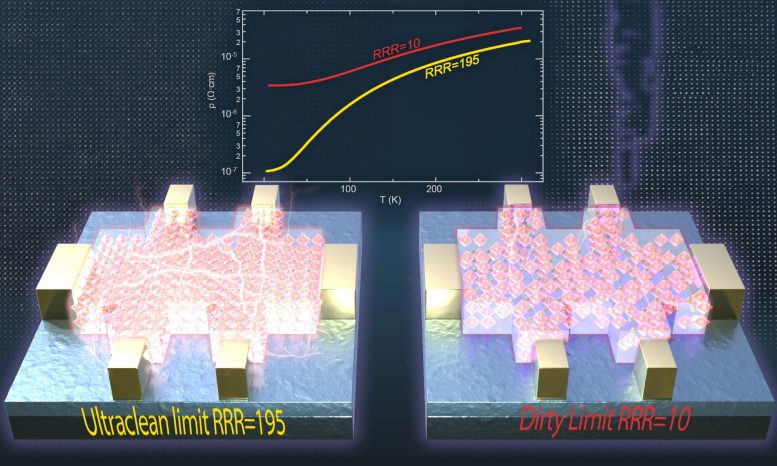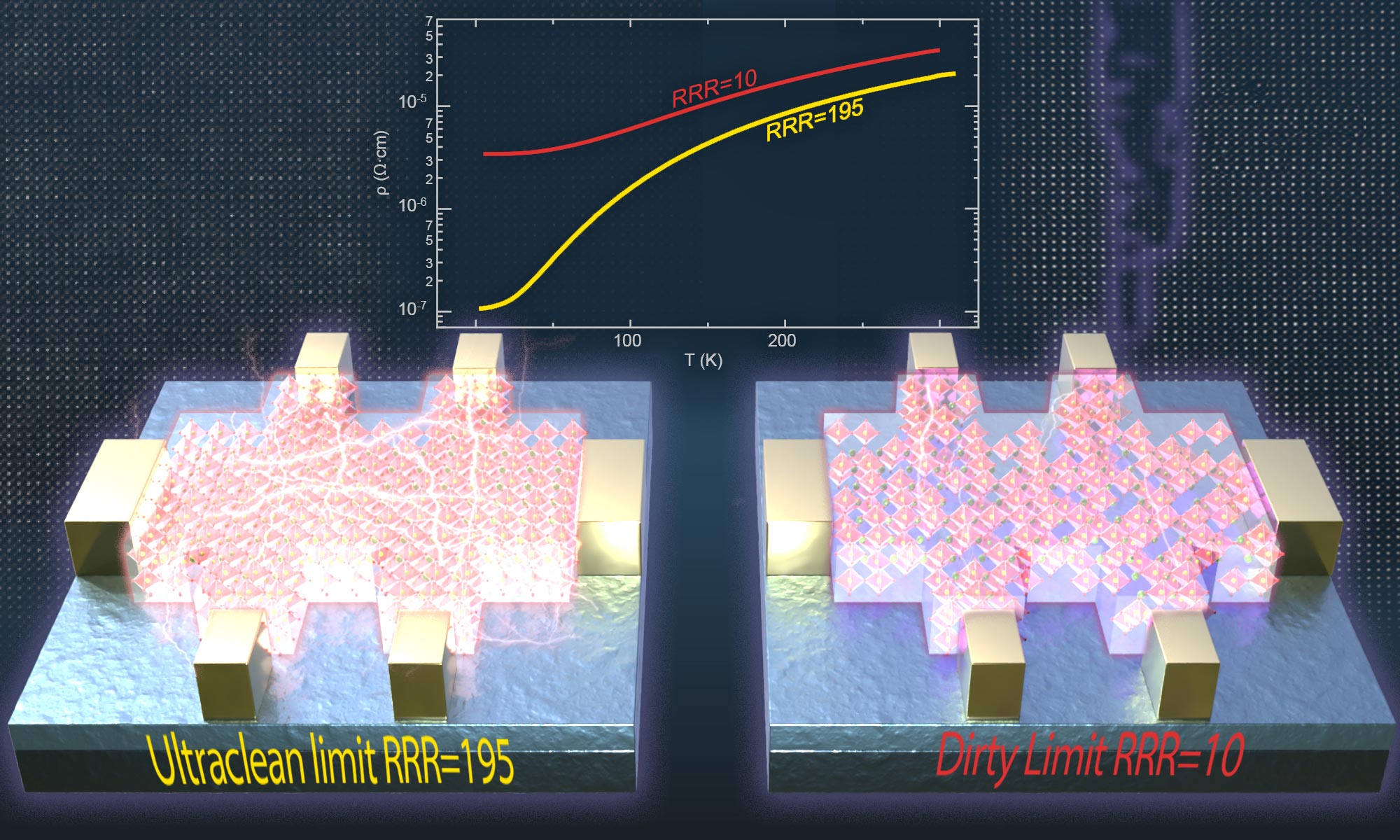Researchers have discovered new phenomena in an ultra-clean sample of SrVO3, challenging existing theories on electron correlations in metals. Credit: SciTechDaily.com
New findings suggest the need to re-evaluate current theories on electron interactions, leading to a better understanding of magnetic properties, high-temperature superconductivity, and the behavior of transparent metals.
Researchers unveiled previously unobserved phenomena in an ultra-clean sample of the correlated metal SrVO3 in a paper published on June 24 in the journal 
Flowing electricity through materials is a simple way to understand their properties. Measurements of ultraclean SrVO3 shown on the left schematically in the Hall bar device and the electron microscopy image, give new insight into the basic phenomena found in correlated electron materials. This is in contrast to SrVO3 that is dense with defects (right). The quality of the materials is manifest in the resistivity versus temperature where the ratio of the resistivity at room temperature to low temperature, RRR indicate the quality, shown in the plot. Credit: ORNL
The Impact of Material Purity on Experimental Accuracy
Another crucial factor in understanding experimental results that guide theoretical models for electron correlation effects is the presence or absence of defects in the material itself. Dr Roman Engel-Herbert, study lead and Director of PDI in Berlin, said, “If you want to get to the bottom of one of the best-kept secrets in condensed matter physics, then you must study it in its purest form; in the absence of any extrinsic disturbance. High-quality materials that are virtually defect-free are essential. You need to synthesize ultra-clean materials.”
Achieving a defect-free sample of SrVO3 has been a seemingly insurmountable challenge until now. By employing an innovative thin film growth technique that combines the advantages of molecular beam epitaxy and chemical vapor deposition, the team achieved an unprecedented level of material purity.
Dr. Matt Brahlek, first author of the study published today, quantifies the improvement: ”A simple measure of material purity is the ratio of how easily electricity flows at room temperature compared to low temperature, called the residual resistivity ratio, RRR value. If the metal contains many defects RRR values are low, typically around 2-5. We have been able to synthesize SrVO3 films with RRR nearly 100 times larger, 200, opening the door to study the true properties of the correlated metal SrVO3. In particular, the high material quality allowed accessing special regime at high magnetic fields for the first time, where surprises were found.”
Unprecedented Findings Challenge Established Theories
The interdisciplinary team of scientists was surprised to discover a series of peculiar transport phenomena that were in sharp contrast to the transport properties measured previously on highly defective samples. Their findings challenge the long-standing scientific consensus regarding SrVO3 as a simple Fermi liquid.
Engel-Herbert explains: “This situation was very exciting but also puzzling. While we reproduced previously reported transport behavior of SrVO3 in our highly defective samples, identical measurements in ultraclean samples with high RRR values differed.” Results from defective samples allowed a straightforward interpretation of the results that matched theoretical expectation. These results were used as experimental evidence that the theoretical understanding correctly captured the electron correlation effects in SrVO3. However, the team found that measurements on the ultraclean samples could not be explained so easily.
Brahlek added: “An observation that stands out is the expectation that the number of electrons that carry electricity in a metal is independent of temperature and magnetic field. This is of course true, but the interpretation of the measured quantity is not a direct measure of the carrier concentration. Rather, this quantity is mixed up with other aspects of the material properties, such as how defects and temperature impact the flow of electricity. We had to delve deeper into the physics to understand what we saw. That is what makes it so important and exciting.”
The researchers believe their discovery can serve as a basis to refine theoretical models and prompt a re-examination of established views and interpretations of materials exhibiting a sizeable electron correlation.
Engel-Herbert says: “Our job as experimental physicists is to push beyond the boundaries of the current understanding of nature. This is where discoveries can be made, where we advance science. As condensed matter physicist it is key to keep perfecting our object of study by challenging ourselves to push the limits of perfecting materials. This can potentially give new insights into the true behavior of this class of materials and enables a comprehensive explanation of the phenomena measured and observed.
“It takes an interdisciplinary team of experts to do this. While the job is not yet completed, our results are an opportunity for the community to recalibrate their theories; re-examining materials we believed were well-understood and re-evaluate their potential for applications.”
Reference: “Hidden transport phenomena in an ultraclean correlated metal” by Matthew Brahlek, Joseph D. Roth, Lei Zhang, Megan Briggeman, Patrick Irvin, Jason Lapano, Jeremy Levy, Turan Birol and Roman Engel-Herbert, 24 June 2024, Nature Communications.
DOI: 10.1038/s41467-024-48043-4
The research team included study lead Roman Engel-Herbert, who conceived and designed the experiment with PI Matthew Brahlek (now at Oak Ridge National Laboratory) who performed the growth, magnetotransport measurements and modeling; Lei Zhang, Joseph D. Roth, and Jason Lapano (Pennsylvania State University) assisted in the growth and characterization, Turan Birol (University of Minnesota) performed theory support, and Megan Briggeman, Patrick Irvin, and Jeremy Levy from the University of Pittsburgh confirmed and validated the magnetotransport measurements to high magnetic fields. The study was supported by the U.S. Department of Energy and the National Science Foundation.
















%20(2)%20(1).jpg)


Discussion about this post